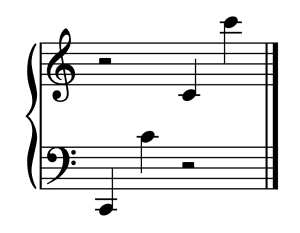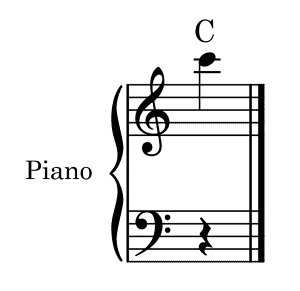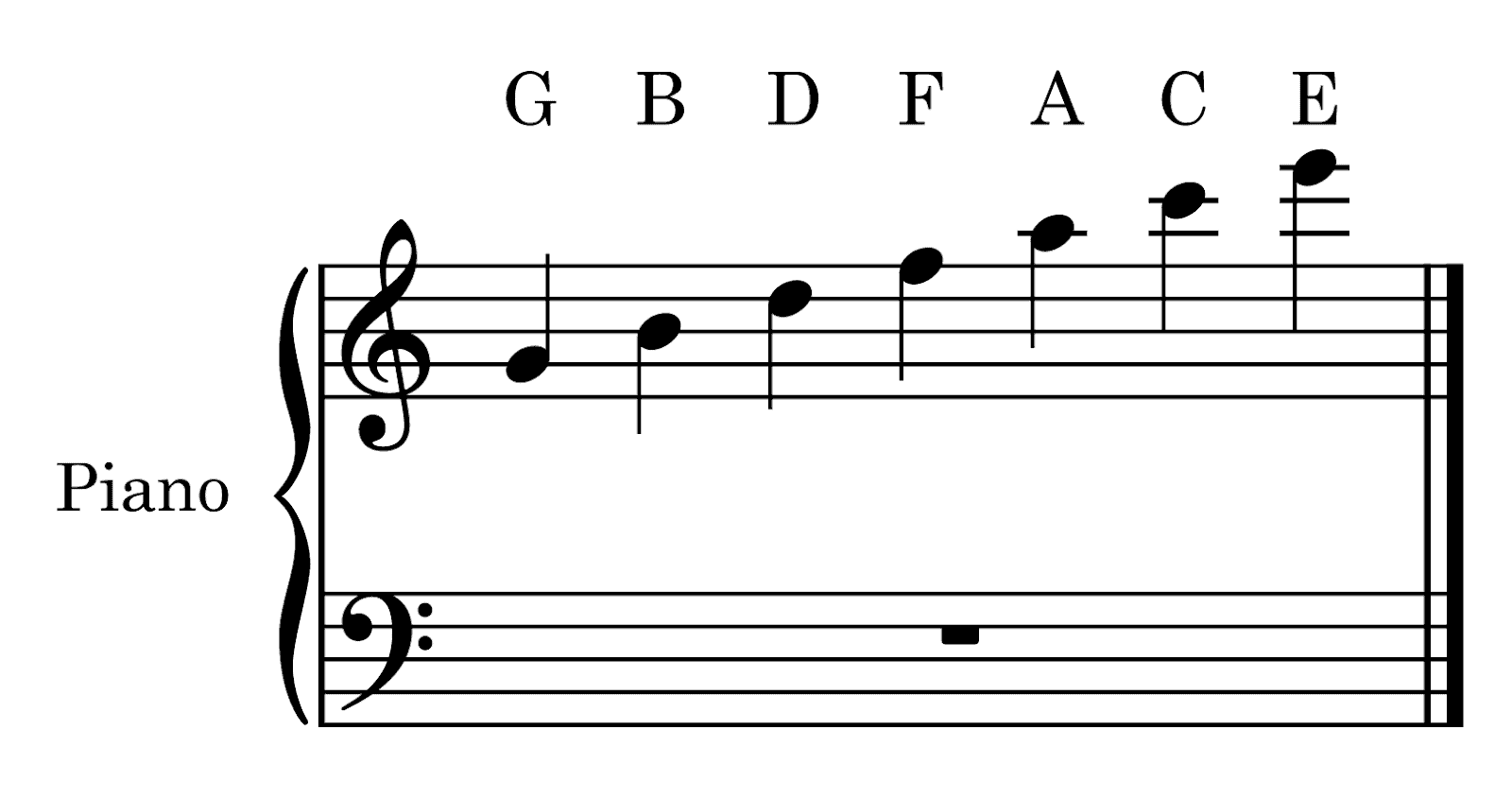Table of Contents
The great strength of learning to play the piano is being able to use the incredibly large range of notes on the keyboard. Standard keyboards have 88 keys, and that gives us a lot of room to work with. Unfortunately, there are only 5 lines on the treble and bass staff. How can we use sheet music to represent really high or really low notes? The answer is simple: We use Ledger Lines. If you’re curious about the ledger lines music definition, this article will teach you everything you need to know.

What are ledger lines?
Whenever we need to read a note that is above or below the treble or bass staff, we use a ledger line. Visually, they are the little lines that represent the lines of the staff, but they are off of the staff. We also use a ledger line to show middle C. These are an important part of learning to read piano sheet music. Let’s look at some piano lines.

These ledger line notes are all C!
Because each clef only has five lines, we have to figure out a way to learn how to read the piano notes names when they fall off the grand staff. The best way to learn to read music when they are off the clef is by using simple rules to remember.
Easy rules to remember:
- Two lines above is C
- Two lines below is C
- In between is C
Two lines above is C
Two lines above the top of the treble clef is a high C. This is a very important anchor point to learn, as it is where many scale patterns end, or it is where many octave patterns begin.

Two lines below is C
Two lines below the bottom of the bass clef is a low C. This is another very important point to recognize, because it is often the lowest note of a song you will play in the key of C. You’ll find this note played very often in the final moments of a piece.

In between is C
In between the two clefs is C. This is very important to learn. Remember, one ledger line below the treble clef, and one ledger line above the bass clef are both C. They are the exact same note. It will be written in a different clef to instruct you about which hand to play.

Why do we need ledger lines?
Ledger lines allow pianists to use the versatility of their instrument while still keeping the music easy to read. Instead of writing music that is only in one place, we can use our ledger lines to play music that is above or below the staff.
The important thing of this is that pianists can learn to play music that was not originally written for the piano! Flute music? Of course! Upright bass music? Definitely! Synthesizer bass lines originally written for pop music? You bet!
One of the effective things is to take a traditional song like Alouette and do creative things with it. Imagine playing the bass part an octave below with ledger lines. Can you hear them ring so low, like the bells of a church in medieval France?
Or another amazing thing to do is to play the song in the correct octave first, and then when you repeat it, to move the whole song an octave above!
Learn to play Alouette here, with the Skoove Piano App!
How to read ledger lines
Now that we understand a few different examples of ledger lines, and we have a quick way to remember and locate C above and below the treble and bass clefs or grand staff, we can now move on to sight reading on just one clef at a time. Remember each clef has five lines and four spaces, and our note names continue in order on the musical staff. We start by looking at our two staves individually. Let us begin with treble clef ledger lines.
How to read ledger lines on treble clef
First thing we need to know is that lines start after the top line. Remember your treble clef notes. The top line of the treble is F, so logically, the next note that follows in the musical alphabet is G. The easy way here is to just continue counting letters, starting after F. The first line note is going to be A, since G is still touching the treble staff. There are several ledger lines.

Avoiding multiple ledger lines on the treble clef
The ledger lines would continue on and on, as the staff represents as many notes as your piano can play. When you take online piano lessons you will learn that in order to avoid ledger lines, many composers will skip writing ledger line notes. When reading music that is very high, often composers will just use an 8va, or “Ottava”, or “octave above” sign.

The notes are still the same, and musicians will recognize that they are the same notes as before, just one octave above. Remember to count your ledger lines when you are sight reading notes on the treble clef.
How to read ledger lines on bass clef
Just like the treble, we use bass ledger lines to play notes that are below our clef. These notes are still on the keyboard, they still exist in written music, they are just very low notes. Remember the bass notes when playing ledger lines that are this low. Our bottom line on the bass is G, so the bottom space below the clef would be F, so our first ledger line is going to be the note E.

Our notes in the musical alphabet work forwards and backwards, so in order to find out which notes we are looking for we start on the bottom space, F. Reading our notes as they descend from the bass staff, our first ledger line is E.
Remember the rule from our first example, two lines below is C. This anchor point lets us figure out any other note that is close to the C. Ledger line notes are actually quite simple!
Avoiding multiple ledger lines on the bass clef
Also like our treble staff, we can play notes that are even too low out of the line. We can actually write a similar symbol to 8va for bass clef, we write 8ba or “Bassa”, which means an octave below. Our notes will appear in the same place in this lesson, but they will sound an octave below.

You’ll notice that this last G an octave below is red on the clef. That is because that note doesn’t exist on the piano keyboard. Keyboards and synthesizers can play that note, but our traditional piano keyboard cannot!
Figuring out line and space notes on ledger lines
Reading music from a page to practice is a great way of learning to play an instrument. However, a lot of music uses complicated notes that are off the staff. How do we figure them out?
The best way to learn to practice Ledger Lines is to get a small piece of music that you are familiar with and then move both of your hands up or down an octave. You should recognize that the notes you feel under your hands are in the same order, and feel the same as they would have before. The notes are the same.
The spaces on ledger line
Next we need to learn to recognize some notes are spaces, as in they fall in between two lines. Don’t panic. The space notes are the same, as an octave below, they just are in a new area!
Look at this example on the treble staff:


The spaces continue in the same order as we would have on the clef, and they always follow the exact same order of letters.
F A C E G B D
It can be useful to memorize this, but it is not required. Skoove is one of the best resources for online piano lessons, and a great place for you to play music that explores music outside the treble staff or bass staff.
The lines on ledger line
You will notice that the spaces on both the treble staff and bass staff follow the same pattern and the same order. Is it the same as a note on the lines?


Clever readers will notice that the space note and the note on the line are the same, except the order of the letters in the word is backwards!
G B D F A C E
Summing the ledger lines
Music is so flexible that over time, musicians and composers needed to change the way that music was physically drawn on the page. This system they created has been so well thought out that it continues to be just as useful and functional as when it was created, even though much of our music uses different instruments.
The versatility is what makes learning to read music so valuable, and it reinforces how important it is to learn to play the piano correctly. One of the best places to learn how to play music online is the Skoove piano teaching app, and you can start your 7-day free trial today!
Author of this blog post:















